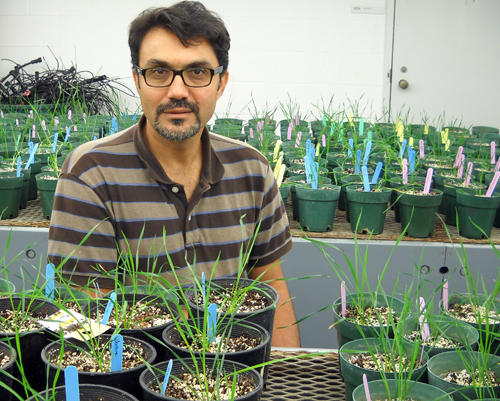
Ali Navabi is looking after your daily bread. A long-time plant breeder with roots in the place where humans grew the first-ever crops, he aims to help develop better wheat for breads, pastries and other foods.
This past spring, he took up the Grain Farmers of Ontario (GFO) Professorship in Wheat Breeding. Those farmers expect his breeding and genetics research will help develop new wheat varieties for Ontario growing conditions, including types that stand up to assorted pests, diseases and environmental stresses.
Navabi’s new faculty position in the Department of Plant Agriculture is supported by a $1-million investment involving GFO, SeCan and the Ontario Agricultural College. SeCan is a not-for-profit group based in Ottawa that supplies farmers with crop seed developed by public and private breeders.
By studying plant genetics, Navabi aims to breed higher-yielding varieties with better grain that are more disease-resistant and that rely less on chemical fertilizers.
His focus is winter wheat, which makes up more than 90 per cent of the province’s wheat crop. About 1.2 million acres of wheat are grown in Ontario, worth about $550 million a year. Wheat makes up the third-largest field crop grown in the province, behind corn and soybeans.
Planted in the fall, winter wheat begins growing in the spring and is harvested in July in Ontario. Spring wheat is planted in the spring for September harvest.
Winter wheat provides higher yield, says Navabi, because it is harvested earlier in the season and it “can avoid some of the diseases” that affect late-season crops.
Like other overwintering crops, winter wheat needs a cold period to flower. That vernalization requirement is controlled by various genes. One of his grad students will study those genetic mechanisms and how altering that vernalization requirement might help wheat better adapt to changing environmental conditions, including temperature.
Navabi will also look at photoperiod response genes that affect how plants adapt to day length.
He hopes to find cultivars more resistant to Fusarium head blight. This fungal disease periodically ravages the Ontario wheat crop, decreasing yield and quality. He’s zeroing in on genes that help plants resist fungal infection and spread.
For this Fusarium project, his lab also received an additional $650,000 in provincial funding and matching SeCan support.
For all of these projects, his team aims to develop novel selection tools and breeding techniques in his marker screening lab in the Crop Science Building. They will cross hundreds of plants in growth rooms and greenhouses and then test the offspring at U of G’s Elora and Woodstock research stations.
By working with graduate students, he says, “We are training a new generation of plant breeders.”
He also works with researchers at Agriculture and Agri-Food Canada (AAFC) and at Guelph’s Ridgetown Campus, as well as with private company breeders.
Navabi arrived at Guelph six years ago as an AAFC research scientist and dry bean breeder and an adjunct plant agriculture professor. He worked with Prof. Peter Pauls and other dry bean researchers in Canada.
“The University of Guelph has a very long history of agriculture and plant breeding,” says Navabi. “This is one of the top universities in North America for agricultural research, so I’m very happy to be at the University of Guelph.”
Most of his career has involved wheat breeding, beginning in Iran. He did two degrees there before coming to Canada for his PhD at the University of Alberta. Along the way, he learned and conducted research at the International Maize and Wheat Improvement Centre in Mexico.
Fascinated by genetics and plant breeding in high school, he completed his undergraduate degree at Shiraz University in southern Iran’s Fars province — what Navabi calls “the wheat province of Iran.”
That’s also where wheat and other cereal crops were first domesticated beginning some 12,000 years ago.
“Wheat was the main crop for me all along. I grew up in its centre of origin and followed it to where it came to North America.”
Over all those millennia of domestication and then scientific breeding, shouldn’t we have made wheat perfect by now?
Referring to anything from new pests and diseases to changing climate, Navabi says the “best” crop is one that keeps adapting to its surroundings. Crops also need to change to meet new consumer product needs.
“There is no such thing as perfect wheat, because as the environment changes, our crop needs to change.”
His wife, Khatereh Sheibani, is a Persian studies professor at York University; they have two sons.